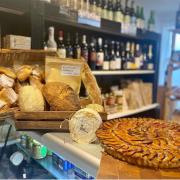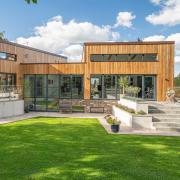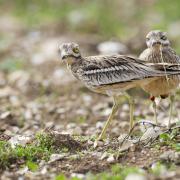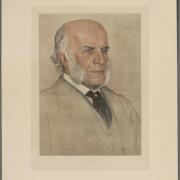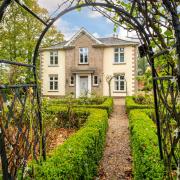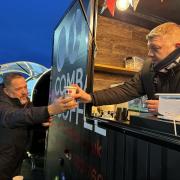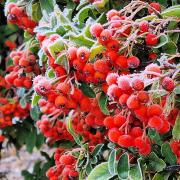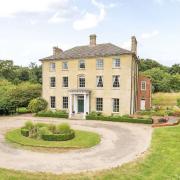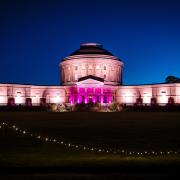“Brown hawker!” The dragonfly streaks its way across the railway tracks in pursuit of June insects that hover hazily. Sue Cox fixes on the hawker’s bronze-gold trajectory, crouching slightly, pointing. “Has it got green eyes? If it does it’s a Norfolk hawker.” She traces the restless, darting route of its slender body and filigree wings, up and down, backwards, forwards. “Green eyes? I think so… do you? Did you see?” The hawker disappears in the direction of Lowestoft before its identity can be determined.
“Painted lady!” The butterfly is more accommodating, pausing on a raspberry-red valerian flower to fan dusty amber, black and white wings. A bee – in pleasingly co-ordinated amber, black and white – bumbles onto a nearby bloom. Another joins it, and another. They rest, feed, fly. “Marsh harrier!” The hunter, quietly quartering the water meadows beyond the opposite platform, pulls our gaze.


Sue, under the scrutiny of Scrabble the station tabby, looks after Somerleyton railway station as a Greater Anglia station ‘adopter’ – the network’s very first, in fact. She shares the work with two other volunteers, Julie Reynolds and Michael Barnard. Together, they ensure that the station on this late-June day is an Adlestrop-esque picture of wild summer fullness, colour and birdsong.
READ: 10 easy family walks in Suffolk
Along the length of the Lowestoft-bound platform, lupins and valerian are stately backdrops to clouds of oxeye and shasta daisies. Scarlet-petalled poppies waft delicately, there are clusters of downy red campion, lilac scabious, and velvety pinks. Nectar-rich wallflowers are finished, but goldenrod, self-seeded sweet william and lofty hollyhocks are about to flower against the red brick walls and apple-green window frames of the station cottage, Sue’s home.
A sea buckthorn hedge, planted last year, is already boosting the numbers of brimstone butterflies whose caterpillars feed on the leaves, and young honeysuckle is clasping onto railings and winding its way among veteran dog roses – both are magnets for pollinators. Bats, foxes, slow worms, frogs and toads have all been spotted on this strip of land.

On the Norwich-bound platform, the planting is a similar mix of old-fashioned cottage-garden, and self-seeding grasses, nettles, comfrey, holly and ivy that spill into the ditch and cattle-grazed meadow beyond. “The regime used to be strim, strim, strim,” says Sue. “That’s stopped now, thankfully. We leave seed-heads on for over-wintering creatures, and the only thing I add to the soil is some mulch in winter. Passengers enjoy seeing the flowers. We get lovely comments, it gives a lot of pleasure.”
Greater Anglia has had volunteer adopters like Sue, Julie and Michael since 2003, but since May, this workforce has partnered with WildEast. The nature restoration project, launched in early 2020 by Hugh Somerleyton and fellow conservationists and landowners Ollie Birkbeck and Argus Hardy, hopes to see 20 per cent of East Anglia (some 250,000 hectares) return to its natural, resilient, biodiverse state by 2050. Why? Because biodiverse, native habitats sequester carbon, the main contributor to global warming, and with the UK government’s ambitions to hit a target of net zero carbon emissions by 2050 now enshrined in law “we all need to do our bit”, says Hugh.

“Of all the things we’ve done, this one is gold,” says Hugh, who was approached by Greater Anglia earlier this year. “Restoration needs to happen at scale and collectively, so a collaboration like this really makes a difference. Railways form the natural ‘green’ corridor that wildlife needs.” A hedgehog may come to the edge of a rough, wild, safe area and find a manicured lawn, Hugh explains, and to that animal, the lawn is like an expanse of desert that contains none of the insects it feeds on. “So the animal stays where it is. And when mammals, insects and birds can’t move safely between habitats, biodiversity is at risk.”
READ: Inside Suffolk's mysterious Martello towers
A ‘map of dreams’ charts WildEast’s progress as farmers, schools, homeowners even with just the tiniest outdoor space, businesses and churchyards pledge their fifth. In just over a year, over a thousand individual pledges have been made, each one pinned onto the lynx-shaped map on the website, with Greater Anglia’s station gardens indicated by a train icon.

By pledging 6,400sqm of railway station land – that’s all 56 station gardens in the network, of which 12 are in Suffolk – Greater Anglia should help WildEast realise its dreams faster, and fill in the map sooner. Not all the stations have Somerleyton’s bucolic charm, but each has done its bit: a slope at Derby Road station on the Ipswich-Felixstowe line has been planted with a pollinator-friendly wildflower mix, and at Westerfield a large wildlife garden is taking shape after residents won funding to transform a large area of wasteland. Led by station adopter Sandy Burn the team has planted perennial grasses and wildflowers and installed a planter for the platform in which the 1st Westerfield Cub Scouts will plant herbs for local people to help themselves.
SUBSCRIBE: Get Suffolk Magazine every month for more great features about life in the county
The partnership with WildEast supports Greater Anglia’s own green message: 10 per cent of all UK journeys are made by rail, it says, yet travelling by train contributes just 1.4 per cent of carbon emissions, a proportion set to reduce further as cleaner ‘bi-mode’ diesel-electric engines replace older stock.

“There’s a misconception that WildEast is all about rewilding the land,” says Hugh. “It’s not. It’s about restoring, rejuvenating it. We’re saying that a rebalancing is needed, and that we need to be immersed in nature, not have it kept in ‘reserves’. There’s a disconnect between people and nature that we need to heal urgently, but in a positive way, not by brow-beating, or preaching.” It is a slow burn, he admits. “But I think that by the time Jonny [Hugh’s 11-year-old son] is my age, we’ll be getting there. I’m optimistic.”
To pledge 20 per cent of whatever outdoor space you have to the WildEast movement, go to wildeast.co.uk. Every pledge helps, however small, and will be recognised on the Map of Dreams.




